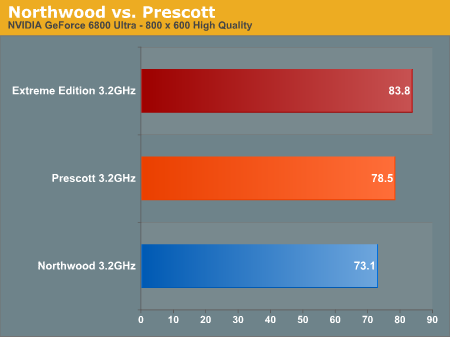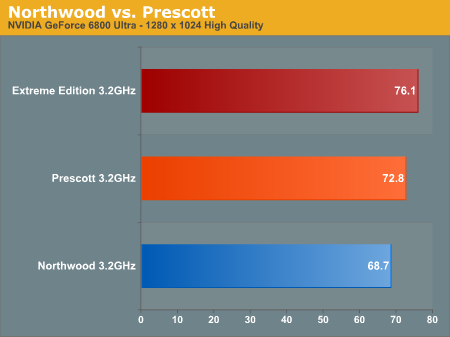Battle 1: Prescott vs. Northwood
The first battle of our Doom 3 CPU Comparison occurs between the two Pentium 4 cores: Prescott and Northwood.
You may remember from our review of Prescott that the new 90nm core was hard pressed to outperform its 130nm Northwood predecessor. Although Prescott featured twice the cache of Northwood, its longer pipeline and similar clock speeds held it back in most performance tests. However, Prescott does have one major advantage over Northwood - twice the L1-D and L2 cache. In other games the added cache has not been able to do much for Prescott, but let's see how that changes under Doom 3:

How the tables have turned - Prescott is actually faster than Northwood for a change, and at the same clock speed. A 7% performance advantage over the regular Pentium 4 3.2C is not too shabby for Prescott, but how can we be sure that the performance advantage is solely due to the cache size advantage? Look at the Extreme Edition.
The 3.2GHz Extreme Edition shares the same core as Northwood, but features a 2MB on-die L3 cache, and manages to outperform Northwood and Prescott by 15% and 7% respectively. These first benchmarks foreshadow what is soon to come and bring about a realization that Doom 3 is quite possibly the most memory/cache dependent game we've ever benchmarked.

The standings remain the same at higher resolutions, but as we've see the 6800 Ultra becomes mostly GPU limited at 1280x1024, reducing the impact of these processors. The Extreme Edition still manages to be 10% faster than Northwood, and Prescott continues to hold a lead over Northwood, just not as much at the higher resolution.
The last thing we wanted to look at in the Northwood vs. Prescott battle was how the two CPUs scaled - as we mentioned in our original Prescott review, we expected Prescott to do a better job scaling with clock speed than Northwood and we are beginning to see examples of that here in Doom 3:

Although it's ever-so-slight, Prescott's performance does seem to scale with clock speed better than Northwood.
The winner of this battle is clearly Prescott, we're sure Intel's happy that there's finally a situation where Northwood isn't in the limelight.










59 Comments
View All Comments
kabob983 - Thursday, September 9, 2004 - link
kabob983 - Thursday, September 9, 2004 - link
So where does the A64 3200+ fit on this scale anyways...above or below the P4 3.4EE?T0918273645 - Monday, September 6, 2004 - link
this statement from their review is partially wrong."Doom 3 sees system memory as one big cache and drives performance up considerably. It is also the on-die memory controller that makes cache size less of an issue on the Athlon 64, while too small of a cache seems to make or break performance with the Pentium 4."
notice the 3.2 E with its 1mb cache gets 72.8 while the 3.2 C with 512KB cache gets 68.7. the only difference between this chips is the cache, which results in a difference of 4.1 FPS.
look at the FX53, with dual channel, and 1mb cache, it gets 103.4
and the 3800+ with 2.4ghz, 512kb cache, and dual channel gets 99.8
a difference of 3.6. So the larger cache does help. I think maybe anandtech might have mixed up the fact that they were comparing with amd the difference between dual channel, and cache. while with intel they were comparing only the difference between caches.
i think looking at the AMD charts you can see how close amd's view of the tradeoff for dual channel with the loss of half the cache actually is, at least as far as doom3 is concerned.
The 3400+ (no dual channel, 1mb cache, and 2.2ghz) performs at 80.4 FPS
The 3500+ (dual channel, 512KB cache, 2.2ghz) turns in 79.5FPS. So the dual channel/ cache tradeoff is so close you'd never be able to tell the difference.
So basically they mixed up the fact that the smaller cach size of the 3500+ compared to the 3400+ is masked by the dual channel ram which nearly completely makes up for the loss in cache.
I'm surpised they overlooked that fact.
Or maybe they thought that a difference of 4.1 is more of an issue than a difference of 3.6, but really that difference is nearly the same.
manson909 - Monday, August 9, 2004 - link
i can't believe no one has thought of this: since Doom 3 is capped at 60FPS, why not compare the MINIMUM framerates the CPU's encounter when playing? a system that has an average of 60FPS but is locked in at this speed (no dips) is far superior than a system that has an average of 70FPS but with lows in the 20's & high's in the 100's imo... anyone?HermosaBeach - Friday, August 6, 2004 - link
Short version:I would like to see the final graph comparing CPUs using 1600x1200, Highest Quality, 4xAA (Anti-Aliasing) and 16xAF (Anisotropic Filtering)
With this graph we may actually see a flattening of the frames per second where an increase in the CPU has no real impact on frames per second. This is where the GPU (GeForce 6800 Ultra) hits the wall and becomes the limiting factor.
Dave
HermosaBeach - Friday, August 6, 2004 - link
Dear 53, I disagree. Here's another way to look at the problem or question. Let's say I own an ATI X800 XT PE. I would like to know what computer (CPU/MB) to get. I want to play games at 1600x1200 with 6xAA and 16xAF. Starting from the slowest computer like the AMD XP 2000+. As you improve the CPU and climb the performance ladder we expect the frames per second to increase. But, there may come a time where an increase in CPU does not appreciably increase the frame rate. At this CPU level getting a faster CPU is not really going to help you. I was hoping to find this magical CPU point. Early 2003, with my ATI 9800 Pro, the sweet spot was the AMD XP 1800+. A faster CPU imporved frames per second, but not by much and was not worth the significantly increase in cost. For example, with FarCry and Doom3 the AMD 64 3000+ might be the sweet spot where getting the AMD 6400 3700+ really does not significantly increase your frame rate. If this is true, I would get the AMD 64 3000+. If the frame per second continue to significant improve as you increase the CPU then I would get the top end CPU. Sadly, at 1280x1024 without 4xAA and 16xAF you really can't tell.Dave
skiboysteve - Friday, August 6, 2004 - link
Dave, your retarded. Try reading the review, esp the first page.HermosaBeach - Thursday, August 5, 2004 - link
This article should have used 1280x1024 and 1600x1200. The 800x600 resolution was a waste of time and reading. Who's going to purchase any AMD 64 or any ATI X800 series or NVidia 6800 series card and play at such pathetic resolutions. I found the article a waste of time and it certainly did NOT answer the question - what CPU to get. I own a ATI 9800 Pro and it certainly did not help with what CPU to get when I purchase my next graphics card - sigh.Dave
xxxfubar187xxx - Thursday, August 5, 2004 - link
Thanks for the benchmarks guys! You do great work over there. Why wasn't the Athlon64 3700+ included in these benchmarks? Being the top of the line Socket 754 processor I figured it would be included in the tests.gimpyd00 - Thursday, August 5, 2004 - link